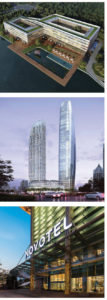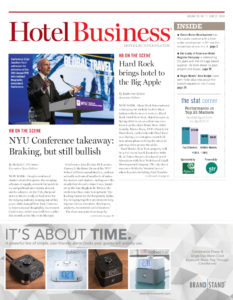SUZHOU, CHINA—Dubbed “The Venice of China,” the city of Suzhou, which flows with canals and waterways, has become an increasingly popular destination for North American travelers, according to the Suzhou Tourism Bureau. The city, located in southeastern Jiangsu Province of East China, has continually expanded its infrastructure, especially with the addition of several new hotels—some of which represent a brand’s first property in China.
Within the next few years, more than eight additional hotels are scheduled to open, according to the bureau. These properties include The Four Seasons, W Hotel, Sheraton, Taihu Lake and Westin—all in 2017. Recent openings comprise the country’s first Wyndham Garden property and the first Element-branded hotel in Asia-Pacific. In addition, its closest international airport, Pudong International Airport, has received an increase in flights from North America by airlines such as American Airlines, China Eastern and Hainan Airlines, providing additional access to the city.

TOP TO BOTTOM: Element Suzhou is located in the Suzhou Science and Technology Town (SSTT), an eco-city adjacent to the commercial and administrative center of the city’s high-tech industrial development zone.
The 150-room Raffles Suzhou is scheduled to open in 2020 and will be situated in the Keyne International Suzhou mixed-use development in the Suzhou New District (SND).
Novotel Suzhou SIP, which opened March 2016, is located in Suzhou Industrial Park. The property faces Suzhou International Expo Center.
Suzhou’s first-quarter 2016 hotel construction pipeline consists of 79 projects with 15,309 rooms, according to Lodging Econometrics. The city has 63 projects currently under construction with eight scheduled to start in the next 12 months and eight in early planning. Suzhou is the fourth largest city for hotel construction in China by project count. The pipeline consists mostly of hotels in the economy and midscale segments, which account for 23 new projects each.
Over the past several years, occupancy has gradually increased in Suzhou, while ADR has decreased and RevPAR has remained stable, according to STR. In 2008 and 2009, occupancy held steady at 43% then gradually increased to 66% in 2014 and 2015. ADR went from $80.57 in 2007 and then $87.44 in 2008 but later decreased to the $63.00 range in 2014 and 2015. RevPAR has remained constant over the years going from $43.26 in 2007 and then declining to $37.84 in 2008 but later rebounding to the $42.00 range in 2014 and 2015.
Based on research conducted by PHG Consulting, the profile of the North American traveler frequenting Suzhou is at least 45 years old and has a disposable income, extensive time to travel, resides in a major U.S. city and has an affinity for arts- and culture-focused travel. Research also indicates a rise in younger travelers visiting the city for educational experiences.
Key drivers fueling business and leisure travel to the city both derive from Suzhou’s proximity to Shanghai—30 minutes by train or two hours by car—and the city’s cultural attractions, according to Lu Feng, deputy director of the Suzhou Tourism Bureau. “Business travelers are not only extending their stay when working in Suzhou, but the city is also receiving those business travelers looking to explore more of China, such as from Shanghai,” said Feng. “For the leisure traveler, Suzhou has been rising rapidly as a modern, international city full of vigor and vitality that combines traditional culture with modern civilization.”
Suzhou offers more than 60 well-preserved classical gardens, nine of which have been designated as UNESCO World Heritage sites. “The leisure travelers who are coming to Suzhou to explore its culture and history may want to stay around the Old Town District, close to attractions and activities, so in those areas boutique hotels with more amenities would have greater success,” explained Feng.
Suzhou attracts business travelers from companies such as Siemens, Nokia, Fujitsu, Mitsubishi, Samsung, Daimler Chrysler, BP and ZF. With four main train stations, the city’s railway system offers frequent “bullet train” runs between Suzhou and Shanghai, which makes it possible to travel between the two cities in 30 minutes, according to Feng.
Additionally, more than half of the Fortune Global 500 companies have established factories or offices in the SIP (China-Singapore Suzhou Industrial Park), built in Suzhou in 1994, noted Feng. The Chinese and Singaporean governments developed the core district jointly. Suzhou is also trying to develop the meetings, incentives, conferences and exhibitions (MICE) market in the SIP and Jinji Lake area. The new Suzhou Jinji Lake International Convention Center opened this past March.
“More and more companies are establishing offices in Suzhou Industrial Park, so hotels that are focused on corporate travelers and MICE business would do well around Jinji Lake,” said Feng.
The newly opened, 289-room Wyndham Garden Suzhou is situated near to Guanqian St. and four garden areas, according to Wyndham Hotel Group. “The number of visitors and tourism revenues in Suzhou are steadily climbing year over year, creating a ripe market for hotel development in one of China’s major economic centers,” said Leo Liu, Wyndham Hotel Group’s president and managing director for Greater China. “With the launch of Wyndham Garden, we’re able to address the needs of visitors looking for upscale accommodations, whether traveling for business or pleasure.”
Environmental protection has become a major factor throughout the country as a result of the Chinese government’s five-year plans on new energy and climate programs, according to Brian McGuinness, global brand leader, specialty select brands, Starwood Hotels & Resorts. This initiative prompted Starwood to open Element Suzhou Science and Technology Town in June 2016. “As Starwood’s ‘eco-innovator,’ the Element brand’s green philosophy aligns with Suzhou Science and Technology Town’s commitment to environmental initiatives and sustainable practices,” said McGuinness.
Suzhou caters to both business and leisure travelers and Starwood’s brands appeal to a wide array of demographics. Four Points targets the business traveler while Element appeals to the business traveler who needs an extended stay, or the leisure yogi travelers. “Suzhou is such a rich, diverse destination with incredible demand so it can accommodate the different lifestyle and luxury brands we will be bringing to the market,” said McGuinness. HB

